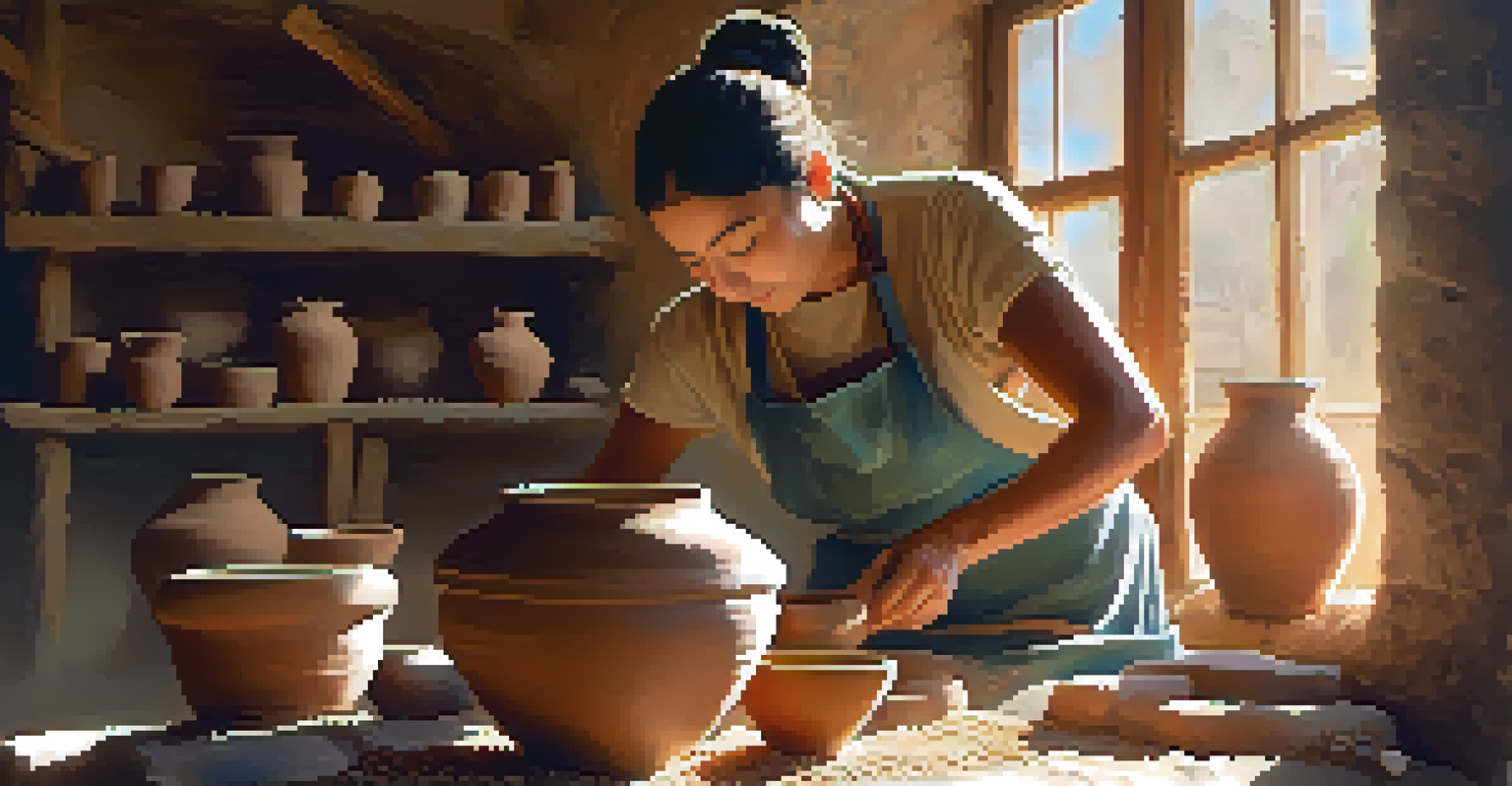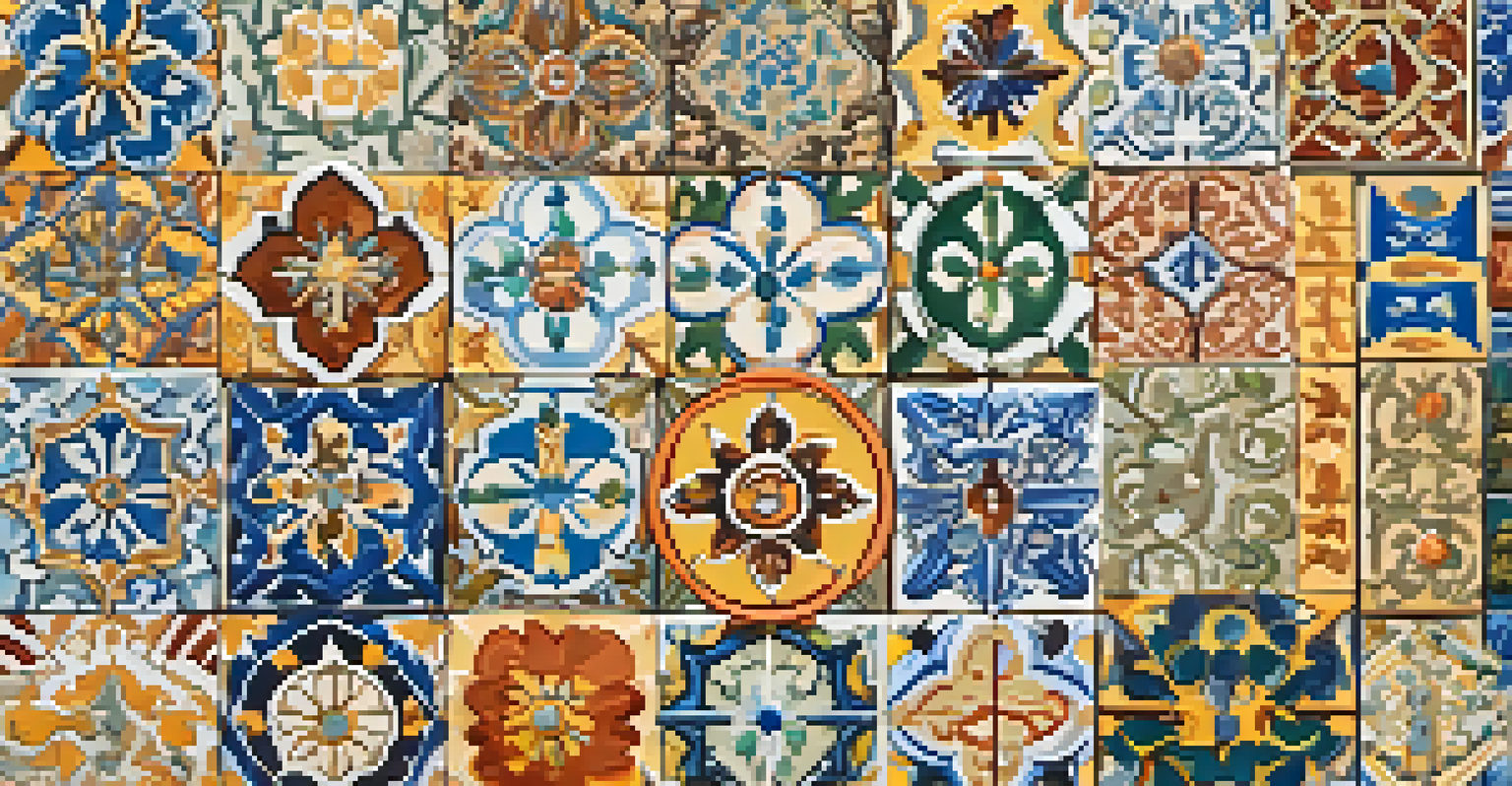Exploring the Art of Spanish Pottery: Techniques and Traditions

A Brief History of Spanish Pottery
Spanish pottery has a vibrant history that dates back thousands of years, influenced by various cultures including the Romans and Moors. Each era introduced unique techniques and styles, contributing to the rich tapestry of Spanish ceramics we see today. Regions like Andalusia and Valencia have become synonymous with distinctive pottery styles, each telling its own story through color and form.
Pottery is not just an object of beauty; it is a vessel of cultural memory and identity.
The legacy of Spanish pottery is not just in its physical pieces but also in the traditions passed down from generation to generation. Many artisans still adhere to age-old practices, ensuring that the essence of their craft endures. As you explore different regions, you can witness how local resources and cultural influences shape the pottery's design and functionality.
From the intricate tile work of Moorish architecture to the simple yet beautiful earthenware of rural communities, the history of Spanish pottery is deeply intertwined with the country's broader artistic heritage. Understanding this history enriches our appreciation for the craft and connects us to the artisans who have dedicated their lives to it.
Key Techniques in Spanish Pottery Making
Spanish pottery is renowned for its diverse techniques, each contributing to the unique character of the pieces. One of the most notable methods is the use of 'majolica,' a tin-glazed pottery technique that produces vibrant colors and intricate designs. This technique allows artisans to create stunning visual effects, making each piece a true work of art.

Another important technique is 'raku,' which originated in Japan but has been embraced by many Spanish potters. Raku involves removing pottery from the kiln while it's still glowing hot, then placing it in combustible materials, creating unique crackled finishes. This method highlights the unpredictability of the firing process, resulting in one-of-a-kind pieces that capture the imagination.
Rich Cultural Heritage of Pottery
Spanish pottery reflects a vibrant history influenced by various cultures, with each region showcasing unique styles and techniques that tell their stories.
In addition to these techniques, traditional hand-throwing and molding methods remain central to Spanish pottery. Artisans often work with clay sourced from local riverbeds, giving their creations a unique texture and color. The tactile nature of the clay not only affects the final product but also connects the potter to their environment, emphasizing the harmony between craftsmanship and nature.
The Role of Color in Spanish Pottery
Color plays a crucial role in Spanish pottery, often symbolizing various cultural and historical influences. Bright blues, yellows, and greens frequently dominate the palettes, reflecting the vibrant landscapes and lively traditions of Spain. These colors are not merely decorative; they often carry deep meanings tied to local customs and beliefs.
Art is the most beautiful of all lies; it captures the essence of life in a way that nothing else can.
In regions like Talavera de la Reina, the use of cobalt blue is particularly iconic, originating from ancient techniques that have been refined over centuries. Artists skillfully combine different colors, creating intricate patterns that tell stories or celebrate local folklore. Each color choice is intentional, contributing to the overall narrative of the piece.
Additionally, the glazes used in Spanish pottery can vary widely, from glossy finishes to matte textures, each affecting the way color is perceived. The interplay of light and texture adds another layer of complexity, inviting viewers to appreciate the artistry from multiple angles. This dynamic relationship between color and form is a hallmark of Spanish ceramics.
Cultural Significance of Pottery in Spain
Pottery in Spain is deeply rooted in cultural identity, serving as both functional and decorative art. In many villages, pottery is not just a craft but a way of life, with families often specializing in specific styles unique to their region. This cultural significance is evident in festivals and markets where pottery is celebrated as a symbol of heritage.
Moreover, pottery serves as a medium for storytelling, with designs often reflecting historical events, local myths, or everyday life. For example, certain motifs may represent agricultural practices or seasonal changes, connecting the community to its land and traditions. This narrative aspect enriches the appreciation for each piece, turning it into a vessel of cultural memory.
Innovative Techniques in Crafting
Artisans employ diverse methods like majolica and raku, demonstrating a blend of tradition and creativity that results in stunning, unique pieces.
As globalization continues to influence craft traditions, many Spanish potters are finding ways to blend contemporary designs with traditional techniques. This fusion not only keeps the craft alive but also allows for new expressions of cultural identity in a modern context. The ongoing evolution of pottery in Spain reflects the resilience and adaptability of its artisans.
Regional Varieties of Spanish Pottery
Spain's diverse geography gives rise to a variety of pottery styles, each with its own unique characteristics. In Andalusia, for instance, ceramics often feature intricate geometric patterns and bright, bold colors inspired by the region's Moorish heritage. This vibrant style draws visitors from around the globe, eager to witness the beauty of Andalusian pottery.
In contrast, the pottery from the region of Catalonia tends to emphasize functionality alongside aesthetic appeal. Known for its utilitarian design, Catalan pottery often features earthy tones and simple forms, making it ideal for everyday use. This practicality does not compromise beauty; rather, it highlights the craftsmanship behind each piece.
Valencia is another region known for its distinctive ceramics, particularly its famous 'azulejos' or decorative tiles. These tiles are often adorned with colorful patterns and are used to embellish everything from buildings to courtyards. Each region's unique approach to pottery reflects local resources, traditions, and artistic influences, making Spanish pottery a rich and varied art form.
Preserving Pottery Traditions in Modern Times
As the world becomes increasingly digitized, preserving traditional pottery techniques is more important than ever. Many artisans are now focused on passing down their skills to younger generations, ensuring that the rich history of Spanish pottery continues. Workshops and apprenticeships are vital in this process, providing hands-on experience and fostering a deep connection to the craft.
Moreover, contemporary artists are finding innovative ways to blend traditional methods with modern design elements. This not only attracts a new audience but also keeps the craft relevant in today’s market. By embracing change while respecting heritage, these artisans are paving the way for the future of Spanish pottery.
Sustainability and Modernization
The future of Spanish pottery emphasizes eco-friendly practices and innovative designs, ensuring the craft remains relevant and connected to contemporary values.
Community support plays a significant role in this preservation effort. Local markets, exhibitions, and cultural festivals highlight the importance of pottery in Spanish culture, encouraging people to appreciate and invest in handmade ceramics. These initiatives help keep the spirit of craftsmanship alive, ensuring that the art of Spanish pottery continues to thrive.
The Future of Spanish Pottery
Looking ahead, the future of Spanish pottery is filled with possibilities. As artisans continue to innovate while honoring tradition, we can expect to see exciting new designs that capture the essence of contemporary life. This evolution is essential for keeping the craft vibrant and appealing to a new generation of collectors and enthusiasts.
Sustainability is also becoming a key focus in the pottery community. Many artisans are now prioritizing eco-friendly materials and practices, reflecting a growing awareness of environmental issues. This shift not only benefits the planet but also resonates with consumers who value craftsmanship and sustainability in their purchases.

Ultimately, the future of Spanish pottery hinges on its ability to adapt and inspire. By merging historical techniques with modern sensibilities, Spanish potters can ensure that their art continues to be a vital part of cultural expression. The journey of Spanish pottery is far from over, and its evolving narrative promises to be just as rich and colorful as the pieces themselves.